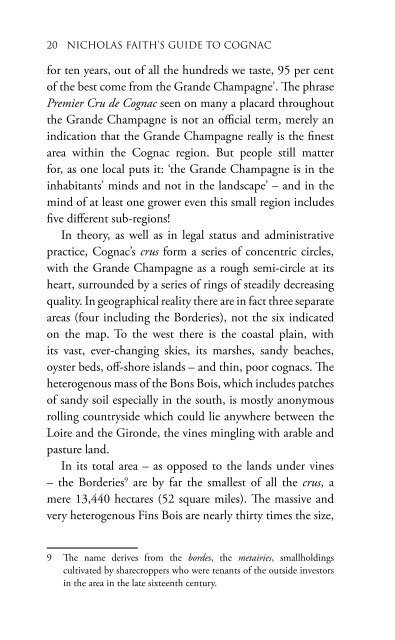Create successful ePaper yourself
Turn your PDF publications into a flip-book with our unique Google optimized e-Paper software.
for ten years, out of all the hundreds we taste, 95 per cent<br />
of the best come from the Grande Champagne’. The phrase<br />
Premier Cru de <strong>Cognac</strong> seen on many a placard throughout<br />
the Grande Champagne is not an official term, merely an<br />
indication that the Grande Champagne really is the finest<br />
area within the <strong>Cognac</strong> region. But people still matter<br />
for, as one local puts it: ‘the Grande Champagne is in the<br />
inhabitants’ minds and not in the landscape’ – and in the<br />
mind of at least one grower even this small region includes<br />
five different sub-regions!<br />
In theory, as well as in legal status and administrative<br />
practice, <strong>Cognac</strong>’s crus form a series of concentric circles,<br />
with the Grande Champagne as a rough semi-circle at its<br />
heart, surrounded by a series of rings of steadily decreasing<br />
quality. In geographical reality there are in fact three separate<br />
areas (four including the Borderies), not the six indicated<br />
on the map. To the west there is the coastal plain, with<br />
its vast, ever-changing skies, its marshes, sandy beaches,<br />
oyster beds, off-shore islands – and thin, poor cognacs. The<br />
heterogenous mass of the Bons Bois, which includes patches<br />
of sandy soil especially in the south, is mostly anonymous<br />
rolling countryside which could lie anywhere between the<br />
Loire and the Gironde, the vines mingling with arable and<br />
pasture land.<br />
In its total area – as opposed to the lands under vines<br />
– the Borderies 9 are by far the smallest of all the crus, a<br />
mere 13,440 hectares (52 square miles). The massive and<br />
very heterogenous Fins Bois are nearly thirty times the size,<br />
9 The name derives from the bordes, the metairies, smallholdings<br />
cultivated by sharecroppers who were tenants of the outside investors<br />
in the area in the late sixteenth century.<br />
354,200 hectares (1,367 square miles); the Bon Bois are<br />
even bigger, 386,600 hectares (about 1,500 square miles);<br />
and the Bois Ordinaires are smaller, 274,176 hectares<br />
(1,058 square miles). Historically the Bois were even more<br />
sub-divided, with the Bois Communs below even the Bois<br />
Ordinaires.<br />
But today the legal definition differs from vinous<br />
reality. Vinous practice has followed the advice of Patrick<br />
Daniou, a leading geographer who in 1983 wrote that: ‘it<br />
seems eminently desirable, in order to defend the quality of<br />
cognac’s brandies, to take greater account of terroir in a new<br />
definition of the cognac appellation, which should be based<br />
on scientific criteria and on boundaries that should not<br />
necessarily be administrative ones.’ 10 By 2000 the vineyard<br />
had shrunk from 110,331 hectares in 1976, to a stable<br />
figure of about 80,000 hectares. As a result there has been<br />
a dramatic change in the importance of the different crus<br />
resulting in an automatic improvement in overall quality.<br />
The contrast is extraordinary. In 1976 the Fins Bois,<br />
Bons Bois and Bois Ordinaires accounted for three-fifths of<br />
the total, while in 2011 it was little more than a half. Over<br />
25,000 hectares of vines had been uprooted, including over<br />
half of those in the Bons Bois while the Bois Ordinaires<br />
lost over three-quarters of their 4,300 hectares. This is not<br />
surprising. As a professional tasting guide pointed out in<br />
1973, these brandies ‘are coarse and hard and lack any<br />
distinction’. The remaining vines are virtually all on the<br />
islands of Ré and Oléron, producing cognacs entirely for<br />
the tourist trade. And, as Pierre Szersnovicz of Courvoisier<br />
remarks ‘the salty, iodiney taste of brandies from near the<br />
10 Annales GREH, 1983.


